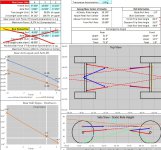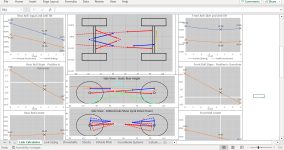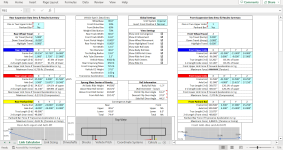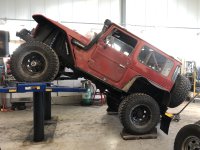Between your post and mine it exceeded the max characters.
It was quiet over there, so I figured some were biting their tongue, but I have thick skin. I can take a flaming about how I am a fucking idiot who can't build suspensions, but at the same time, give the reason so when someone else reads my build thread in 10 years from now, they can learn. I spent too much time reading 15 year old threads wading through "OP doesnt know shit" to find the 2-3 solid answers on WHY OP doesn't know shit.
I will go comment by comment but first start off by saying that I appreciate the input, am willing to make changes (at this point after I drive it) and am committed to this rig so I will make the changes as I see fit. I have redone my 3 link front a couple times, gone through numerous coil spring, shocks/shock tuning and ultimately to coilovers, axle swaps, changing link locations etc. so I just want people to know the advice won't fall on deaf ears and is a waste of time as people type stuff out to give me advice. With all that said, any changes won't be immediate since it is brand new. I will also say, building a link suspension in a weekend has its pros and cons, pros: its done fast! Cons: hindsight is 20/20 so I may see things differently after. I had a friend fly out, we worked our asses off and accomplished a lot but in order to do that we couldn't ponder much. So anyways, thank you for the solid input, I do truly appreciate it.
Ok, on to business.
Lower link angle. In reality I could have gone further back and use a shorter link bracket, but link angle is 7* at ride height, I thought it wasn't terrible. Jake Burkey on busted knuckle rock rods tech videos says keep it under 10*. I thought that was under 10* at ride height, maybe he meant at its steepest angle? Either way, it is something I can change in the future if it is problematic. I can say that I CANT inboard my links unless I ditch the factory tank and if I ditch the factory tank then I will go with a 4 link. While all the pics were on the pass side, the factory tank is on the driver side and is right up against the frame rail so inboarding is a no go, and trust me, if I could, I would have, I saw benefits to inboarding my lower links up front when I did that. I wish I could.
I will touch base on a few topics here. Anti squat, upper link placement, and COG. One of the few things I had going for me in this build is that the H3 has a metric fuck ton of room for frame side upper link placement. I could place (2) 4 hole brackets on top of each other and still have room to cut up a 3rd one and have a total of 10 holes so the adjustability is basically infinite in my opinion. I threw in my COG all the way down to 30 for reference (which I highly doubt it is) and I can still get it under 100% with my current layout. I would be willing to put in the work to find my true COG. Heres some info on COG, think thats the correct formula?
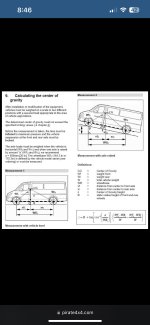
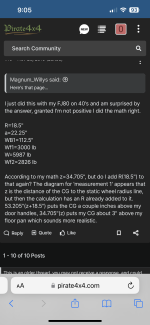
So, I am not concerned on Anti Squat, I am very confident I can get it right, I just need to know what my true COG is so I can accurately place the link on the frame side. As for axle side upper link placement it wasnt really for anti-squat, it was a priority that I am placing this upper link bracket as high as I can to reduce load off the upper link, I would figure out anti squat later and it just so happens that going up that much helped my anti squat.
As for track bar, yeah. I agree 100%, of course I wish it was flatter. I would have to go back and look; I can't remember if I could put it over the upper link. I may have room for it. I was stoked that I was having a 41in long track bar, I asked a few others with 3 link rears and it was longer than anyone else, but I guess it doesn't matter because it sits at 13* angle at ride height. I vividly remember having it longer then it was and it ran into the upper link because they travelled at different planes. The quick answer was shorten it a few inches, if we had more time, maybe we would have chosen other options. Anyways, I can't lower my frame side in its current position because it would hit the 3rd member at full bump. I could potentially bring my axle side over the upper link. The reason I didnt go behind the axle is because the coilovers were there. I see that 4WU puts their track bar behind the axle and the coilovers behind the axle. From pics it looks like to do that they put GIANT coilover mounts to space the coilovers far off the axle tube. I didn't want that kind of leverage on something that holds my vehicle up, especially because I weigh quite a bit more than a toyota. So thats why the track bar went behind the axle. Admittedly I am nervous about rock crawling performance with the coilovers and links in big boulder canyons. In the canyons my leafs were sprung over, the mount was short and tucked up way higher on the frame side then the links, I had nothing below the axle tubes. Leafs worked awesome there but then on ledges, even with an anti wrap bar, I felt the power wouldnt hit the ground immediately, the springs wanted to wrap in certain situations and loads. So this brings me to the next topic of outboarding. I was concerned that outboarding would cause clearance issues. My framerail is very wide. Off of memory it is 43in wide. My axle WMS (with spacers) is 69in wide. It is something I will consider though. I felt like we just wrote it off because of how wide my axle is. Id be curious if my coilovers are mounted wider then a TJ just because my frame is that much wider compared to a TJ with outboarded coilovers. Probably not apples to apples but I would be curious. They are angled back and inboard compared to the axle so I hope the inboard frame side does provide some stability because of the direction they are going.
Readers digest version: Maybe I could put the axle side track bar up above the upper link, or get it back behind the axle and live with giant pain in the ass hanging 12in behind the axle tube coilover mounts or go behind the axle, put coilovers outboard and in the cab and on top of the axle tube but dont really wanna go in the cab.
One last question, my COG to roll center, I want predictability and stability, is there a percentage between the two for that? It seems the higher the roll center, the more stable it is but the less predictable it is?
I think I covered it all. I really do appreciate all the insight and would be interested in any other opinions from others or comments from you on this.
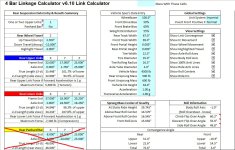
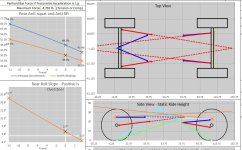




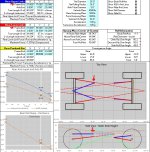
 .
.